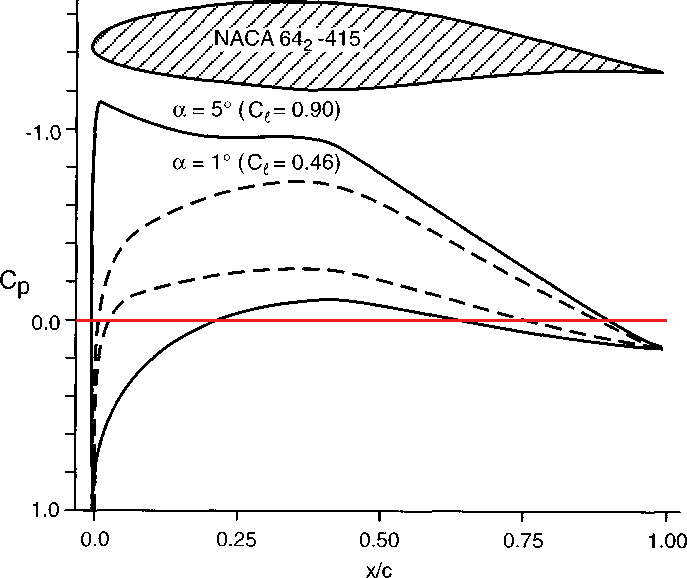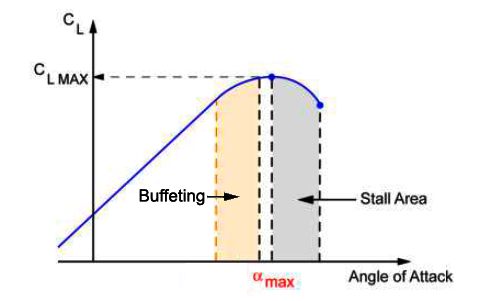Leeham News and Analysis
There's more to real news than a news release.
 Leeham News and Analysis
Leeham News and Analysis
- Solid start for stand-alone GE Aerospace despite cuts to LEAP output April 23, 2024
- SPEEA, Boeing at impasse over safety program, union says April 23, 2024
- Better transparency needed on Boeing’s 1Q earnings call April 22, 2024
- Bjorn’s Corner: New engine development. Part 4. Propulsive efficiency April 19, 2024
- Boeing unlikely to meet FAA’s 90-day deadline for new safety program April 18, 2024
Bjorn’s Corner: Aircraft lift, Part 2
March 30, 2018, ©. Leeham News: In the last Corner, we described how lift is produced on the aircraft’s wings. Now we continue with studying the lift a bit further.
We explore the effect of angle of attack on lift for a wing and the resulting pressure distribution.
Aircraft lift
Aircraft wings have a cross section called an airfoil. Airfoils for airliners are specially formed to fly at high Mach speeds. Before we go to these airfoils, we explore lift using a classical airfoil, designed for lower speeds.
I found a good description what happens with an airfoil when the angle of attack against the air is varied. The airfoil profile in Figure 2 is a NACA laminar wing profile and the graph is from the excellent book Race Car Aerodynamics by Joseph Katz. I’ve used the graph because he’s illustrative explanations are among the best.

Figure 2. The effect of angle of attack on the lift and pressure distribution of a wing profile. Source: Katz, Race Car Aerodynamics.
When the air hits the front of the wing, the part of the air taking the top route curves around a convex shape, the wings nose. The speed of the air increases and the static pressure (Cp) decreases. At low angle of attack (1° in this case), the curving builds the top dotted pressure curve, passing into negative Cp. We have suction (negative pressure relative to surrounding air pressure) from 2% of the wing chord to around 90%.
For the air taking the route past the bottom of the wing, there is a slight suction created as the air speeds up when it curves around the convex section until 75% of the cord. Then the wing profile has a concave shape, which slows the air down and a positive pressure builds (the lower dotted line passes the zero line downwards).
If we increase the angle against the air (the 5° line), the suction has a peak early on the wing profile at a higher suction level. The pressure curve for the bottom of the profile has positive pressure at the beginning and end of the profile.
To calculate the profile’s lift, one sums the two curves, to a total lift called Cl. This is the lift per unit wing area. It has been made independent of the speed of the air and the air’s density.
As we can see the lift of the air is concentrated more to the front of the wing when alfa increases. A wing without a stabilizing tail would flip over backwards, even if the initial tendency to flip over could be controlled with a forward centre of gravity.
As alfa increases, the flipping moment increases and the forward CG doesn’t help anymore. This is what happened to one of Jack Northrop’s flying wings at a test flight after the war. The test pilot didn’t listen to warnings about the dangerous high alfa characteristics, pulled the flying wing into a high alfa situation, flipped over and crashed.
Flying wings have only become popular again (B2, B21, different UAVs) when Fly-By-Wire flight controls could make the Pilot avoid the dangerous high alfa regime of a flying wing.
Airfoil stall
As the angle of attack is increased further, the air can’t curve around the nose of the wing anymore. The boundary layer breaks away and the wing loses lift, it stalls (Figure 1). Before a wing passes into a stall, it’s starting to shake. Pilots talk about “wing buffet”.
This is a warning the airflow has problems to follow the wing’s top curvature, it breaks loose over areas of the wing. When designing a wing it’s important this separation of the flow starts at the inboard section of the wing so the outer section, equipped with ailerons, still has a functioning airflow. By it, the pilot can stop the aircraft from dipping its wings. Designers use wing twist to achieve a local lower angle of attack for the outer section of a wing.
In the next Corner, will look at a transonic wing’s pressure distribution.
Related
Category: Bjorn's Corner
Tags: Aerodynamics, Flying wings, Lift
6 Comments on “Bjorn’s Corner: Aircraft lift, Part 2”
Leave a Reply Cancel reply
Email Subscription
Twitter Updates
My TweetsAssociations
Aviation News-Commercial
Commentaries
Companies-Defense
Resources
YouTube
Archives
- April 2024
- March 2024
- February 2024
- January 2024
- December 2023
- November 2023
- October 2023
- September 2023
- August 2023
- July 2023
- June 2023
- May 2023
- April 2023
- March 2023
- February 2023
- January 2023
- December 2022
- November 2022
- October 2022
- September 2022
- August 2022
- July 2022
- June 2022
- May 2022
- April 2022
- March 2022
- February 2022
- January 2022
- December 2021
- November 2021
- October 2021
- September 2021
- August 2021
- July 2021
- June 2021
- May 2021
- April 2021
- March 2021
- February 2021
- January 2021
- December 2020
- November 2020
- October 2020
- September 2020
- August 2020
- July 2020
- June 2020
- May 2020
- April 2020
- March 2020
- February 2020
- January 2020
- December 2019
- November 2019
- October 2019
- September 2019
- August 2019
- July 2019
- June 2019
- May 2019
- April 2019
- March 2019
- February 2019
- January 2019
- December 2018
- November 2018
- October 2018
- September 2018
- August 2018
- July 2018
- June 2018
- May 2018
- April 2018
- March 2018
- February 2018
- January 2018
- December 2017
- November 2017
- October 2017
- September 2017
- August 2017
- July 2017
- June 2017
- May 2017
- April 2017
- March 2017
- February 2017
- January 2017
- December 2016
- November 2016
- October 2016
- September 2016
- August 2016
- July 2016
- June 2016
- May 2016
- April 2016
- March 2016
- February 2016
- January 2016
- December 2015
- November 2015
- October 2015
- September 2015
- August 2015
- July 2015
- June 2015
- May 2015
- April 2015
- March 2015
- February 2015
- January 2015
- December 2014
- November 2014
- October 2014
- September 2014
- August 2014
- July 2014
- June 2014
- May 2014
- April 2014
- March 2014
- February 2014
- January 2014
- December 2013
- November 2013
- October 2013
- September 2013
- August 2013
- July 2013
- June 2013
- May 2013
- April 2013
- March 2013
- February 2013
- January 2013
- December 2012
- November 2012
- October 2012
- September 2012
- August 2012
- July 2012
- June 2012
- May 2012
- April 2012
- March 2012
- February 2012
- January 2012
- December 2011
- November 2011
- October 2011
- September 2011
- August 2011
- July 2011
- June 2011
- May 2011
- April 2011
- March 2011
- February 2011
- January 2011
- December 2010
- November 2010
- October 2010
- September 2010
- August 2010
- July 2010
- June 2010
- May 2010
- April 2010
- March 2010
- February 2010
- January 2010
- December 2009
- November 2009
- October 2009
- September 2009
- August 2009
- July 2009
- June 2009
- May 2009
- April 2009
- March 2009
- February 2009
- January 2009
- December 2008
- November 2008
- October 2008
- September 2008
- August 2008
- July 2008
- June 2008
- May 2008
- April 2008
- March 2008
- February 2008



What’s the graph reading from top to bottom?
Solid, 5 bottom of wing
Dot, 1 top of wing
Dot, 1 bottom of wing
Solid, 5 top of wing
?
From top to bottom:
Solid, 5 top of wing
Dot, 1 top of wing
Dot, 1 bottom of wing
Solid, 5 bottom of wing
Observe the scale is inverse. Top is lowest pressure, bottom highest. This is the standard way to draw pressure diagrams for wing profiles.
Thanks, that makes sense. In the 1 degree case, it looks like the maximum negative pressure is at about 38% of the wing chord. I assume this means these forces are acting against each other, upward suction on the top of the wing, and downward suction on the bottom of the wing. Seems like you should subtract the downward force from the upward force rather than add them?
Cp, is that pressure normal to the surface?
Exactly, it’s the integrated Cp difference, not sum. Pressure is always normal to the surface.
Going back to ‘aircraft drag reduction part 2’ in October, I’d be curious what the comparison of this pressure graph along the chord of a wing is for two cases described there. A flat plate at 20 degrees, and a cambered wing section at 20 degrees. I would guess that a flat plate sees no suction on top.
Looking at Fig. 2 above, for the 5 degree case, estimating area above and below the red line, it looks like the top of wing generates 5 to 10 times the amount of lift than the bottom of wing. This goes against my intuition, although that has always been the description of the main component of how lift works, the Bernoulli principle. Also interesting that the negative pressure from this effect (-1.2), can exceed the direct pressure of a surface normal to the slipstream of 1.0
The CL/CD is insteresting “The glid ratio”, which commercial airline has the best presently? One can assume that a light weight aircraft with a big wing can be optimized easier for the best Cl/Cd.
I bet the new ERJ190, A330-800, B787-9, A350-900, MRJ90, CS100, 737MAX7, A319neo, MC-21 and Sukhoi SSJ100 can be in the race.